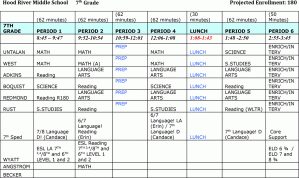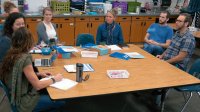Connecting Student Learning Across Subjects
When teachers collaborate on projects across subjects, they can drive engagement in all of their classes.
Your content has been saved!
Go to My Saved Content.Overview
At Hood River Middle School, school leaders create time for teachers to collaborate within and across content areas on projects. This has many benefits, including:
- Teachers can leverage resources, ideas, and learning opportunities.
- Students make connections between subjects.
- It communicates a common message across classrooms, showing students that their teachers are aware of what they're learning in other classes.
- It keeps teachers on the same page in terms of not assigning too much homework on any given night or scheduling tests on the same day.
"When teachers talk to each other, teachers learn from each other," says Brent Emmons, Hood River Middle School's principal. “There are so many great ideas that our teachers come up with that engage kids and get kids to think outside the box. I'm just amazed at what we can accomplish when we work together.”
How It's Done
For Principals
Step 1: Schedule time for collaborative planning.
"You have to provide the structure for collaboration; that's essential,” states Emmons. “You can't have collaboration if teachers don't have time to collaborate."
Hood River’s grade-level teachers benefit from:
- Daily common preparation time and lunches
- A required weekly meeting for collaboration
The daily prep time creates a scheduled opportunity for informal collaboration, but given teachers' workload, that time isn't always used for collaboration. The weekly required meeting ensures that they collaborate.
"In the education world, there isn't a lot of attention that is traditionally paid to the master schedule," says Emmons. “The schedule is the bones of a school, and that's what we hang curriculum after; that's what you actually provide for a culture of a school. By tweaking a master schedule, you can provide opportunities for collaboration.”

Tip for Principals: As a principal, you need to encourage and recognize your teachers for collaborating. To create an atmosphere where your teachers feel encouraged to try new things -- in addition to time -- it's also important to provide them with a budget, advises Emmons.
Step 2: Define the budget for collaborative planning.
Teachers at Hood River come together on more robust cross-curricular activities rooted in their community, ranging from field trips to the Columbia River Gorge to launching a weather balloon into the Earth's atmosphere. Bringing these projects to life requires funding for resources. Emmons created an internal grant funded by parent and community donations to support teacher projects and collaboration -- the Hood River Middle School (HRMS) Building Grant.
"I use parent fundraising and donations to fund classroom grants from teachers,” explains Emmons. “I believe it encourages innovation and allows families to see the direct benefit to student learning that donations and fundraising provides for the kids of our community."
For teachers to apply, the funding needs to benefit the kids directly and cannot go toward staff development. The project also needs to be aligned with Common Core. Teams can request up to $1,000, and individuals can request up to $400. For 2015-2016, the school will distribute $4,000 through this grant.
To apply, teachers fill out the HRMS Building Grant application, including their name or team member names, the subjects and grades that will be taught, the title of their project, and the project description and budget. They also answer the following statements and questions:
- Describe how the funds will be spent.
- Describe the project timeline.
- Clearly state the learning objectives.
- Explain what the project will accomplish and how it will be evaluated.
- Discuss any anticipated obstacles.
- How many students will benefit from the short- and long-term of this project?
Their review application committee consists of Principal Emmons, parent volunteers, and Vice Principal Ocean Kuykendall.
For Teachers
Step 1: Start by finding one collaborative partner.
Adam Smith, a Hood River sixth-grade math, science, and language arts teacher, came across a video online called "Hello Kitty Goes to Space," showing a seventh-grade student launching a high-altitude weather balloon into the atmosphere and capturing data while in flight. After seeing that video, he knew that he wanted to adapt this project for his classroom and make it a collaborative effort across content areas. He reached out to sixth-grade engineering teacher, Rebekah Rottenberg, who was just as excited to bring this project to life.
"Having that one other team member that was fired up about collaborating created enough inertia to get this project started," says Smith.
Step 2: Get resources.
Whether you're planning a large or small collaborative project, you'll need funding and resources. Once Smith and Rottenberg partnered together, they created a budget and submitted a Hood River Middle School Building Grant application. They received funding for a flight computer, the balloon, helium, and a few GoPros to capture the footage of the balloon in flight.
Tips on Getting Funding: If there aren't internal grants available at your school, here are nine online resources that you can use to raise money for your collaborative project.
Step 3: Share your idea with your grade-level team.
"We had a clear idea in mind of what we wanted to do upon retrieving our weather balloon," recalls Smith. Reinforcing sixth-grade topics like watershed, atmospheric science, engineering design, and scientific inquiry were part of their plan. "It was great to bring the topic to the rest of the team to find out how we could connect it to language arts and other content areas."
During one of their grade-level meetings, the language arts teachers brainstormed a way to connect the journey of the balloon to both creative and scientific writing by having their students write about that single experience from different perspectives.
"The beauty of the weather balloon project is that it's something captivating that provides many points of entry,” says Smith, “whether you're a student in an engineering class working on how to build a structure that's going to survive a fall from several thousand meters, or if you're in a science classroom trying to ask good scientific inquiry questions that could be tested, or if you're in language arts and you want to write a creative piece about what the balloon's journey might be."
Step 4: Continue to update your team at grade-level meetings.
Collaborative projects aren't planned in the span of a single meeting. They evolve over time. Laura Haspela, a Hood River seventh-grade science teacher, and her colleague Anne Marie Untalan, who teaches seventh-grade science and math, brainstormed over the summer about a grade-wide field trip to Fossil, Oregon, where their students could dig -- knowing that archeology interested their students -- and focus on the geology of that area.
When they shared this idea with their grade-level prep team, they realized it was unfeasible. "It ended up that we had a limited budget," says Untalan. They brainstormed together, and instead decided to go to the Columbia River Gorge.
They developed their curriculum over time. In their first meeting, they realized that they could connect the Gorge to reading class by studying local legends. At their following meeting, both language arts teachers expanded on the idea of legends, deciding that kids could write their own legend. "That brought in social studies talking about how people back in the olden days -- before science explained why these things existed -- made up these legends to explain why things existed," says Angie Adkins, a Hood River seventh-grade language arts teacher. In language arts, they later came up with the idea for their students to present their legends through skits, storybooks, comic strips, puppet shows, and iMovies. Their curriculum continued to develop over time as they shared ideas during their grade-level meetings.
Step 5: Use informal spaces for collaboration.
Time in between classes is great for quick, informal conversations. While passing a colleague in the hallway, Smith will often say, "I have this great thing I want to try today. If it works out for me, I'll let you know. You should try it out tomorrow, and then we can see where we can go from there.'"
These on-the-fly, organic discussions are great for encouraging flexibility and adapting practices easily and quickly, but with a lack of time, it's not always possible. To ensure grade-level collaboration, grade-level meetings are necessary. Those meetings need to be scheduled, and that time needs to be protected.
"Because of that common prep time, it allows every team to figure out how to make the curriculum more real for students," says Untalan. "Those collaborative conversations were starting on the bus ride back home after the Columbia River Gorge field trip because the kids are on board. They're excited; they're enthusiastic; and they were commenting about all they had learned."
